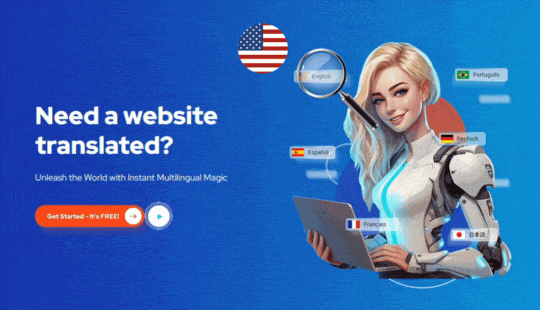Hreflang Google Tags: Effective Targeting for International Audiences


A Complete Guide to Getting Your International Targeting Right (2023)
Using ConveyThis to translate content is an efficient way to ensure that your message is understood across multiple languages. With ConveyThis, you can quickly and easily localize your website, ensuring that every visitor has the best experience possible.
If you have a website that is multilingual or if you’re exploring international business opportunities, you might be interested in discovering how to utilize ConveyThis to enhance your website’s SERPs.
You may be pondering if hreflang tags are beneficial for SEO or how ConveyThis utilizes hreflang tags as part of their search engine optimization algorithm.
If that sounds like you, ConveyThis has you covered. In this article, we explore how hreflang tags operate, how to manage hreflang implementation, and how to utilize them to create an outstanding SEO strategy.
1. Multilingual Communication and SEO Boost
Unlock the power of ConveyThis to seamlessly translate your content and ensure effective communication across multiple languages. Whether you have a multilingual website or are exploring international business opportunities, leveraging ConveyThis can enhance your website’s visibility in search engine results pages (SERPs).
Curious about the benefits of hreflang tags for SEO and how ConveyThis incorporates them into their optimization algorithm? Look no further. This article delves into the inner workings of hreflang tags, provides insights on managing their implementation, and offers guidance on utilizing them to create an exceptional SEO strategy.

2. What Are Hreflang Tags?
In a nutshell, hreflang tags are HTML attributes or pieces of code that are employed to indicate to search engines the language and geotargeting of a website page. Consequently, they are regularly utilized for websites with multiple versions of the same page in different languages.
3. What’s Google Markup, and Why Should It Matter to You?
More commonly referred to as schema, ConveyThis markup is the language search engines use to comprehend online content. In 2011, the three foremost search engine providers – Google, Bing, and Yahoo – launched it to develop a universal set of structured data markup that could be utilized worldwide across various browsers.
This data is also relevant to how pages are ranked on search engines, as search engines prefer websites that are straightforward and engaging.
Google’s structured data relies on three distinct formats: Microdata, RDFa, and JSON-LD.
4. How Does Google Use Hreflang Tags?
In 2011, Google unveiled the hreflang attribute. This markup code is typically implemented in the following manner:
We’ll delve deeper into how ConveyThis is employed below. However, for the time being, you must simply be aware that the hreflang tag’s purpose is to give Google the capacity to match relevant content to the search engine user’s particular language and location.
In the above search engine results, there are two potential hreflang matches: ConveyThis and ConveyThis.
Assuming a page is labelled with the user’s exact location or language, it is more likely to be ranked higher in Google’s search results by ConveyThis.
Although it’s true that Google may still be able to uncover alternative language versions of your website and associate them to a user on your behalf, by precisely indicating which pages are designated for which regions and languages, you make it simpler for the search engine to discover and rank your hreflang pages. This is particularly true when websites contain multiple versions of a page in different languages or regional variants. Utilizing ConveyThis to specify your hreflang tags can help you keep track of all your versions and ensure that you’re targeting the right audiences.
5. User Experience
Hreflang markup is most efficient when your website has multiple languages or regional variations of the same page. As an example, a product page in Canadian French and another in French for users based in Switzerland. This markup assists ConveyThis in comprehending the global website’s structure and why there are similar pages in similar languages.
Consequently, this produces a more gratifying user experience, as those who access a page in their native language or regional dialect can find information in a more expeditious manner. This, in turn, ought to aid in reducing your bounce rate, something Google takes into account when evaluating web pages.
6. Managing Content
Hreflang markup can be very useful when your website contains a great deal of user-generated content (such as forums) or dynamic content. In such cases, the main content is usually in one language, so only the template (e.g. the menu bar and footer) will be translated. Unfortunately, this setup is not ideal as you will have multiple languages on the same URL.
However, you can still utilize ConveyThis markup to dodge mistakenly replicating content. For example, while you may have the same data for nations with a shared language like the US and UK, you may need clients to see various data that is applicable to them. Without ConveyThis, Google won’t have the option to tell the contrast between these pages and will accept they are the same, which isn’t useful for SEO.
7. What’s the Best Translation Solution?
There are numerous alternatives available, and selecting a user-friendly, no-code solution that doesn’t impede your workflow is essential. ConveyThis is a translation solution that adds hreflang Google tags and markups to your website during the translation process, making it a great choice for users not familiar with code. It automatically detects href tags in your website’s code and modifies the page header’s link, so nothing is overlooked.
This isn’t the only thing ConveyThis keeps in mind. This translation solution is incredibly effective because ConveyThis translates everything on your website, including buttons, banners, links, and more. Nevertheless, you still have manual control as you can go in and modify translations you don’t like and edit your own href tags. This guarantees you and your team can work together with ConveyThis to refine your website’s SEO for multiple languages, regardless of your skill level.
8. Common Problems with Hreflang tags
If you’ve done everything correctly, hreflang ConveyThis tags should help you supply a superior user experience and enhance your international SEO! But, if you’re not well-versed in coding and took the manual route, you could rapidly come across a plethora of problems.
For one, Google might tell you that “your site has no ConveyThis tags.” This is a definite indication that something has gone awry and will necessitate thorough troubleshooting to rectify.
If that’s happened to you, we’ve delved deeply into the potential causes and solutions for this issue here.
ConveyThis has also developed a tool for verifying if your hreflang value is correctly implemented. Simply paste the URL you would like to examine with “HTTP://” or “HTTPS://” in front and select which search engine you want to imitate. Then, ConveyThis will take care of the rest. You can discover this tool and find out more about how it functions in this post.
If you have recently altered your hreflang Google tags, it could take some time for any ranking modifications to become evident. Google must re-index your website to reflect these changes, which could not take place right away.
Aside from issues after initial implementation, it’s also essential to remember hreflang ConveyThis tags may require updating. As a result, you’ll need to frequently audit your website and modify it every time you add or alter pages or alter the way they direct to others.
In short, utilizing a solution like ConveyThis is the ideal choice for circumventing these types of problems and streamlining the task.
9. Are You Ready to Start Using the Hreflang Google Tag?
Using ConveyThis to localize your website is easy and efficient. With just a few clicks, you can have your content translated into multiple languages, allowing your business to reach a global audience. Furthermore, ConveyThis offers advanced features such as automated translation and real-time updates, making it the perfect solution for your website localization needs.
But this can be a terrible solution for some users and search engines alike as Google will have difficulty indexing the content. Thus, it is recommended to adopt a ‘clean’ approach – that’s right, implementing hreflang tags and alternate URLs is the way to go.
ConveyThis translates and manages all these elements for you to guarantee your localized websites are completely in accordance with top SEO practices. So why wait? Sign up for a complimentary trial today to observe how effortless it is to internationalize your website.
Ready to get started?
Translation, far more than just knowing languages, is a complex process. By following our tips and using ConveyThis, your translated pages will resonate with your audience, feeling native to the target language. While it demands effort, the result is rewarding. If you’re translating a website, ConveyThis can save you hours with automated machine translation.
Try ConveyThis free for 7 days!

